Argentina
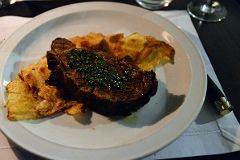
Nothing Beats The Argentinian Steak At Francis Mallman's 1884 Restaurante In Mendoza
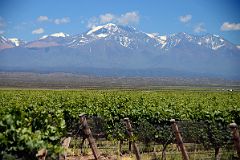
The Vineyard At Pulenta Estate With Cerro Plata Behind On Lujan de Cuyo Wine Tour Near Mendoza
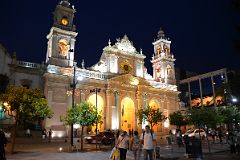
Salta Cathedral Outside After Sunset
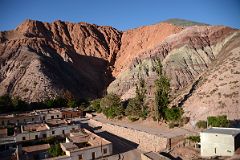
Cerro de los Siete Colores The Hill of Seven Colours Early Morning In Purmamarca
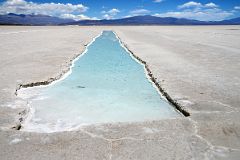
Salt Pool At Salinas Grandes Dry Salt Lake Near Purmamarca Argentina
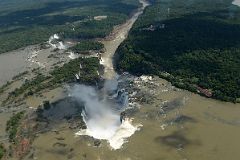
Full View Of Garganta del Diablo Devils Throat, Argentina Falls And Rio Iguazu Superior And Inferior From Brazil Helicopter Tour To Iguazu Falls
Please see separate photo galleries on Buenos Aires, and Aconcagua.
Argentina is a large and diverse country with enough varied landscapes, architecture and art, and personality to exceed any traveller's desires. For our first foray, we visited three of the highlights: Mendoza wine country, Salta's dramatic colourful landscapes, and Iguazu Falls which makes Niagara Falls look rather small.
The fun started on our flight from Santiago in Chile to Mendoza with views of the Andes and Aconcagua, the highest mountain in the Americas.
Mendoza
After landing in Mendoza, we had a very pleasant stay at the Park Hyatt across from Plaza Independencia and visited the four main squares - Plaza San Martin, Plaza Chile, Plaza Italia and Plaza Espana. We had our first delicious Argentinian steak at chef Francis Mallman's 1884 Restaurante housed in the Bodega Escorihuela winery. Beautiful wrought iron gates welcome me to Parque General San Martin, a tree-filled park with a rose garden and a lake. A few kilometres from the centre is Cerro de la Gloria (The Hill of Glory) with the splendid Army of the Andes statue and views over all of Mendoza.
Mendoza is the heart of the revived Argentinian wine industry. One day we toured four wineries in nearby Lujan de Cuyo with mountain backdrops. We enjoyed the favourite Argentinian wine, Malbec, and many others, and ended with a delicious lunch featuring another Argentina steak. On the second day we toured three wineries in a bit distant Uco Valley, capped once again with a delicious lunch.
We had to fly from Mendoza to Salta through Buenos Aires, but got caught in a typical Argentinian strike. The airport shut down at 5pm with everybody having to exit airplanes and wait until the strike was over at 7pm. After a brief round of applause from the passengers, we boarded our flight and took off.
Salta
Salta is nestled in the Northwest corner of Argentina and has a rich history and preserved colonial architecture. We stayed at the Hotel Salta, a National Cultural Heritage neo-Classical building right in front of the main plaza, 9 de Julio. The Plaza 9 de Julio has a monument to Argentine General Juan Antonio de Arenales, a fountain, and is filled with people young and old, especially at night. Surrounding the plaza are the colonial Salta Cabildo, the Centro Cultural America, EL Palacio Galerias, Hotel Continental, and Museo Arquelogico de Alta Montana (MAAM) which contains a mummified body of a child discovered at the peak of Llullaillaco in 1999.
The pink and yellow coloured Salta Cathedral dominates the north side of the plaza. I went inside when it opened and was surprised at how many people were there for the first mass of the day. After gazing up the central nave to the decorative main altar, I walked up the side aisles decorated with many statues and paintings, including a replica of the original Nuestra Senora del Milagro (Virgin Of Miracles) and Senor del Milagro (Lord Of Miracles). I was surprised that there was a non-religious monument to General Martin Guemes who fought during the 1810-1818 Argentine War of Independence.
Completing the tour around the Plaza 9 de Julio are the Museo de Arte Contemporaneo (Museum Of Contemporary Art) and Teatro Provincial de Salta. The nearby Iglesia San Francisco (Saint Francis church) is painted a photographic red and has a bell tower, a statue of San Francisco (Saint Francis de Assisi) and a cell Of Fray Mamerto Esquiu Iglesia outside. Inside is the main altar, paintings and statues including the statue of Nino Jesus de Aracoeli. A few blocks away is the Iglesia San Bernardo Church with its convent, and further away is the beautiful blue coloured Iglesia Nuestra Senora de la Candelaria Church.
The next day we drove out of Salta on our day trip through Quebrada de Cafayate. Quebrada de las Conchas was our first stop with a view of a river flowing through a fertile valley with eroded red hills. The first official tourist stop is Garganta del Diablo (The Devil's Throat), a short walk up a narrow canyon followed by the Anfiteatro (Amphitheatre). We stopped briefly at El Sapo (The Toad) and drove by El Fraile (The Friar), Casa de Loros (Parrot's House), and El Obelisco (The Obelisk) rock formations. We descended through colourful hills to Los Castillos (The Castles) and the Rio de los Conchos. After exiting Quebrada de Cafayate, we drove through the wide open Valles Calchaquíes (Calchaquí Valley) and entered the village of Cafayate. We visited the Cafayate main square and had wine tastings and lunch at Bodega Nanni, which has over 110 years of family winemaking tradition. We discovered the delicious slightly sweet Torrontes wine, unique to this area of Argentina.
We drove north from Salta to Purmamarca with its famous Cerro de los Siete Colores (The Hill of Seven Colours). We stayed at the very comfortable Marques De Tojo Hotel with a welcoming pool to cool off. The main square Plaza 9 de Julio is surrounded by people selling Bolivian-style woven blankets, alpaca wool clothing, hats, and scarfs. The Iglesia de Purmamarca Church has a nearby ancient algorrobo tree said to be around 700 years old. I climbed the small Cerro El Porito hill in the early morning for the best view of the many colours of the rocks on Cerro de los Siete Colores and the village of Purmamarca. In the late afternoon, I walked the Paseo de los Colorados which circles the Cerro de los Siete Colores with views of colourful eroded hills.
In the early afternoon we drove west from Purmamarca up the zig zags of Highway 52 to its highpoint at 4170m and then descended past colourful hills to Salinas Grandes, a dry salt lake stretching to the mountains.
We drove north on Highway 9 out of Purmamarca up the Quebrada De Humahuaca past the Paleta Del Pintor hill to the Pucara de Tilcara, a partially restored defense fortress on a hill above Tilcara with giant cactus, an archaeologist's monument for those who first excavated Pucara de Tilcar, and views to the old town, the highway and colourful hills. We had to wait for 30 minutes at an impromptu road strike before reaching Humahuaca with its Monumento a los Heroes de la Independencia (Monument to the Independence Heroes), Iglesia de la Candelaria y San Antonio Church, and a statue of San Francisco Solano which appears every day from the clock tower to bless the people.
Iguazu Falls
After landing at Puerto Iguazu airport we drove into town to stay at the comfortable Hotel Jardin De Iguazu in Puerto Iguazu. The next morning we drove from Puerto Iguazu to Brazil, stopping at the Argentina border post, driving across the border bridge and stopping at the Brazil border post where we showed our Brazil visa. The first stop in Foz de Iguazu Brazil was at the helicopter pad where we boarded a 6-seater and took off. The quick flight flies over forest and then circles around the Iguazu Falls with perfect views of both the Argentina and Brazil sides and the the Garganta del Diablo (Devil's Throat).
After buying our admission tickets, we boarded a bus to take us to the Hotel Das Cataratas, where we started our visit to the Brazil side of Iguazu Falls. Our first view was to the Argentina falls including Salto Dos Hermanas and Salto Bosetti. We then walked on a narrow trail with more views of Argentina falls and tourist boats on the river before a view up the Rio Iguazu Inferior to Garganta Del Diablo (Devil's Throat). We donned our water geer to walk out to the misty Brazil viewing platform with views directly down and up to Salto Floriano falls and the Garganta Del Diablo.
The Macuco Safari starts with a drive through the forest, stopping briefly to admire the Timbauva tree before walking the final portion to the dock. After donning our life vests and water geer, we boarded the boat and sped up the river over some rapids to our views of the Argentina falls. The boat continued driving towards Garganta Del Diablo (Devil's Throat) where the driver took us directly under some falls to get wet. Good fun! We then drove back to Argentina.
On our second day we drove back near the airport to the entrance to the Argentinian side of Iguazu Falls. We walked from the entrance on tree-lined Sendero Verde (Green Trail) with birds and a toucan. We started with the Paseo Inferior (Lower Trail) past Salto Alvar Nunez Waterfall with views of the Brazil side and the Argentinian side, getting wet at Salto Bosetti, and the smaller Salto Dos Hermanas. After finishing the Lower Trail we switched to the Paseo Superior (Upper Trail) with more views of the Argentinian side.